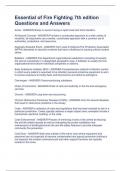Exam (elaborations)
Essential of Fire Fighting 7th edition Questions and Answers (All Chapters)
- Course
- Institution
Essential of Fire Fighting 7th edition Questions and AnswersEssential of Fire Fighting 7th edition Questions and AnswersEssential of Fire Fighting 7th edition Questions and Answers Acute - ANSWER-Sharp or severe having a rapid onset and short duration. All-Hazard Concept - ANSWER-Provides a c...
[Show more]



